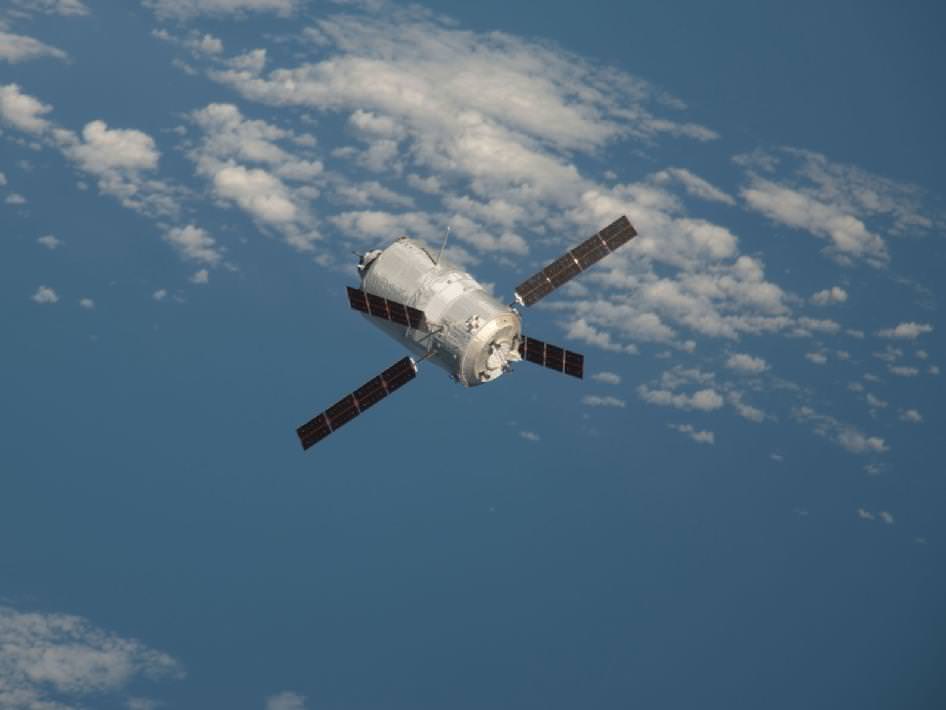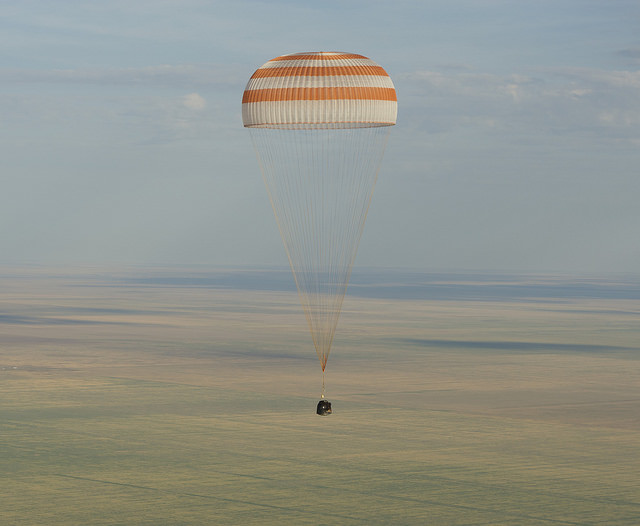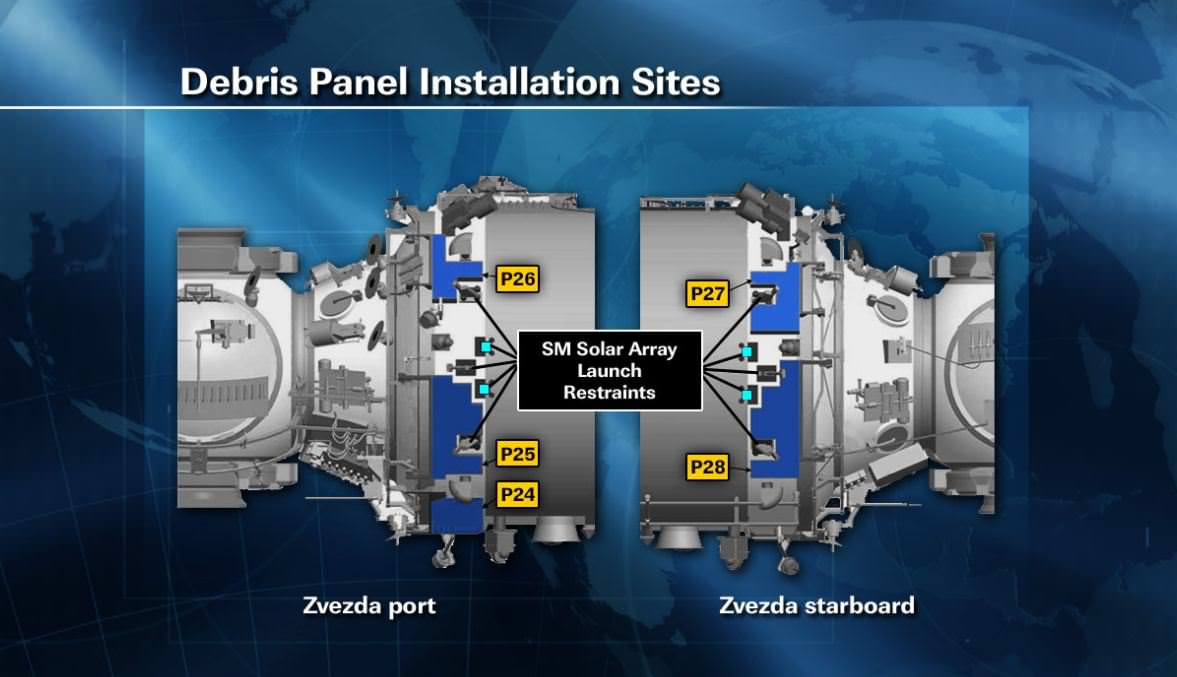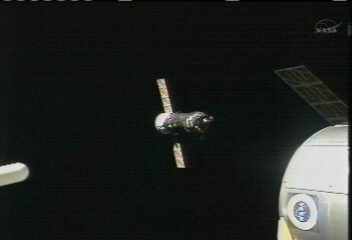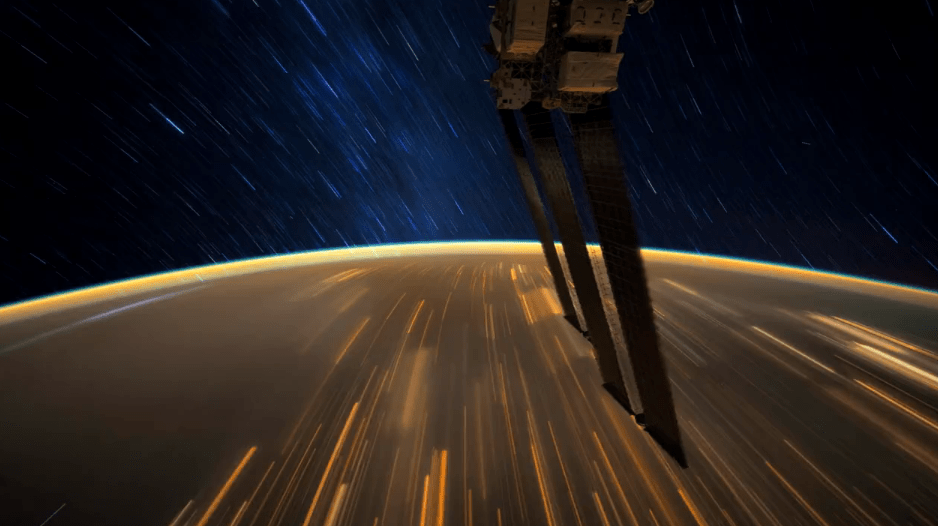Wish you could be on the International Space Station right now, helping to unload the SpaceX Dragon capsule that is berthed to the Harmony Node? A new interactive panorama from SpaceX allows the closest experience of being inside Dragon. Inside, you can see all the storage compartments, and the panorama lets you zoom around inside as if you were floating in Zero-G. If you watch out the window port, the view will change from seeing Earth, to having the protective shutters closed and then (sadly) you end up back on Earth inside the SpaceX Hanger at Cape Canaveral. The panorama is a fun Friday diversion, but make sure you share it with your favorite budding astronaut — kids will love it! Click on the image above to get to the panorama, or use this link.
Antares Commercial Rocket Reaches New Atlantic Coast Launch Pad
Image Caption: Antares Rocket At Wallops Flight Facility Launch Pad. Orbital Sciences Corporation’s Antares rocket at the launch pad at NASA’s Wallops Flight Facility. In a few months, Antares is scheduled to launch a cargo delivery demonstration mission to the International Space Station as part of NASA’s Commercial Orbital Transportation Services (COTS) program. Credit: NASA
At long last, Orbital Sciences Corporation has rolled their new commercially developed Antares medium class rocket to the nation’s newest spaceport – the Mid-Atlantic Regional Spaceport (MARS) at Wallops Island,Va – and commenced on pad operations as of Monday, Oct 1.
The long awaited rollout marks a key milestone on the path to the maiden test flight of the Antares, planned to blast off before year’s end if all goes well.
This is a highly noteworthy event because Antares is the launcher for Orbital’s unmanned commercial Cygnus cargo spacecraft that NASA’s hopes will reestablish resupply missions to the International Space Station (ISS) lost with the shuttle’s shutdown.
“MARS has completed construction and testing operations on its launch complex at Wallops Island, the first all-new large-scale liquid-fuel launch site to be built in the U.S. in decades,” said David W. Thompson, Orbital’s President and Chief Executive Officer.
“Accordingly, our pad operations are commencing immediately in preparation for an important series of ground and flight tests of our Antares medium-class launch vehicle over the next few months. In fact, earlier today (Oct. 1), an Antares first stage test article was transported to the pad from its final assembly building about a mile away, marking the beginning of full pad operations.”
Antares 1st stage rocket erected at Launch Pad 0-A at the Mid-Atlantic Regional Spaceport (MARS) at NASA Wallops Flight Facility in Virginia. Credit: NASA
In about 4 to 6 weeks, Orbital plans to conduct a 30 second long hot fire test of the first stage, generating a total thrust of 680,000 lbs. If successful, a full up test flight of the 131 foot tall Antares with a Cygnus mass simulator bolted on top is planned for roughly a month later.
An ISS docking demonstration mission to the ISS would then occur early in 2013 which would be nearly identical in scope to the SpaceX Falcon 9/Dragon demonstration flight successfully launched and accomplished in May 2012.
The first commercial resupply mission to the ISS by SpaceX (CRS-1) is now set to lift off on Oct. 7 from Cape Canaveral, Florida.
The 700,000 lb thrust Antares first stage is powered by a pair of Soviet era NK-33 engines built during the 1960 and 1970’s as part of Russia’s ill-fated N-1 manned moon program. The engines have since been upgraded and requalified by Aerojet Corp. and integrated into the Ukrainian built first stage rocket as AJ-26 engines.
Image Caption: Antares first stage arrives on the pad at NASA_Wallops on Oct. 1. First stage approaching adapter ring on the right. Credit: NASA
NASA awarded contracts to Orbital Sciences Corp and SpaceX in 2008 to develop unmanned commercial resupply systems with the goal of recreating an American capability to deliver cargo to the ISS which completely evaporated following the forced retirement of NASA’s Space Shuttle orbiters in 2011 with no follow on program ready to go.
“Today’s (Oct. 1) rollout of Orbital’s Antares test vehicle and the upcoming SpaceX mission are significant milestones in our effort to return space station resupply activities to the United States and insource the jobs associated with this important work,” said NASA Associate Administrator for Communications David Weaver. “NASA’s commercial space program is helping to ensure American companies launch our astronauts and their supplies from U.S. soil.”
The public will be invited to watch the Antares blastoff and there are a lot of locations for spectators to gather nearby for an up close and personal experience.
“Antares is the biggest rocket ever launched from Wallops,” NASA Wallops spokesman Keith Koehler told me. “The launches will definitely be publicized.”
ESA’s Big Cargo Ship Departs from the Space Station
After a three-day delay, the European Space Agency’s “Edoardo Amaldi” Automated Transfer Vehicle (ATV-3) undocked from the aft port of the International Space Station’s Zvezda service module at 21:44 UTC (5:44 p.m. EDT) on Friday.
Tuesday’s initial attempt to undock the European cargo ship was called off due to a communications error between the Zvezda module’s proximity communications equipment and computers on the ATV. Russian flight controllers resolved the problem, but then an additional delay occurred because of the possibility of two pieces of space debris coming close to the ISS, and the ATV would have been used to perform an avoidance maneuver; however, it was later deemed the debris posed no threat.
Image of the ATV-3 when it reached the International Space Station on March 28, 2012. Credit: NASA TV
Expedition 33 Flight Engineers Yuri Malenchenko and Aki Hoshide, who together closed up the hatches to ATV-3 Monday, monitored its automated departure from a control panel inside Zvezda. Meanwhile, Commander Suni Williams photographed the departing space freighter to document the condition of its docking assembly.
ATV-3, now filled with trash and unneeded items, backed away to a safe distance from the orbiting complex after undocking. Once it reaches distance about 4,500 miles in front of the station, the European cargo craft will fire its engines twice on Tuesday, Oct. 2, to send it into the Earth’s atmosphere for a planned destructive re-entry that evening. As the ATV-3 plunges back to the Earth, the Re-Entry Breakup Recorder that Hoshide installed inside the vehicle will collect and transmit engineering data to enhance the efficiency of spacecraft designs and minimize the hazards to people and property on the ground even in the case of an uncontrolled re-entry for future cargo ships.
“Edoardo Amaldi,” named for the 20th-century Italian physicist regarded as one of the fathers of European spaceflight, delivered 7.2 tons of food, fuel and supplies to the orbiting complex after docking to the station March 28. The fourth ATV, named “Albert Einstein,” is slated to launch in April 2013. More than 32 feet long — about the size of a traditional London double-decker bus – the ATV is the largest and heaviest vehicle that provides cargo resupply for the station.
Expedition 32 Lands Safely in Kazakhstan
Welcome home to Gennady Padalka, Joe Acaba and Sergei Revin! The trio landed safely in Kazakhstan at 02:54 UTC on Monday, September 17 (8:53 a.m. Kazakhstan time Monday, 10:53 p.m. EDT Sunday, September 16). Expedition 32 officially ended when Soyuz TMA-04M the trio undocked at 23:09 UTC Sunday from the Poisk module. The had been on the International Space Station since May 17, spending a total of 123 days on the orbital laboratory.
The Soyuz TMA-04M spacecraft is seen as it lands with the Expedition 32 crew. Credit: NASA/Carla Cioffi
Expedition 33 is now underway as Commander Suni Williams and Flight Engineers Aki Hoshide and Yuri Malenchenko continue their stay until Nov. 12
Padalka ceremonially handed the controls of the station over to Williams on Saturday afternoon. He previously commanded two International Space Station missions including Expeditions 9 and 19. His first spaceflight was aboard the Russian Mir space station in 1998 bringing his total spaceflight experience to 711 days.
Here’s the undocking video:
Williams is serving her second mission in space, her first being Expedition 14 as flight engineer. She has conducted six spacewalks, four during Expedition 14 and two on Expedition 32, for a total of 44 hours and two minutes.
A new crew is set to join Expedition 33 when Flight Engineers Kevin Ford, Oleg Novitskiy and Evgeny Tarelkin launch Oct. 15 aboard the Soyuz TMA-06M spacecraft for an Oct. 17 docking to Poisk. Ford will command Expedition 34 when Williams, Hoshide and Malenchenko complete their mission.
On the Hunt for High-Speed Sprites
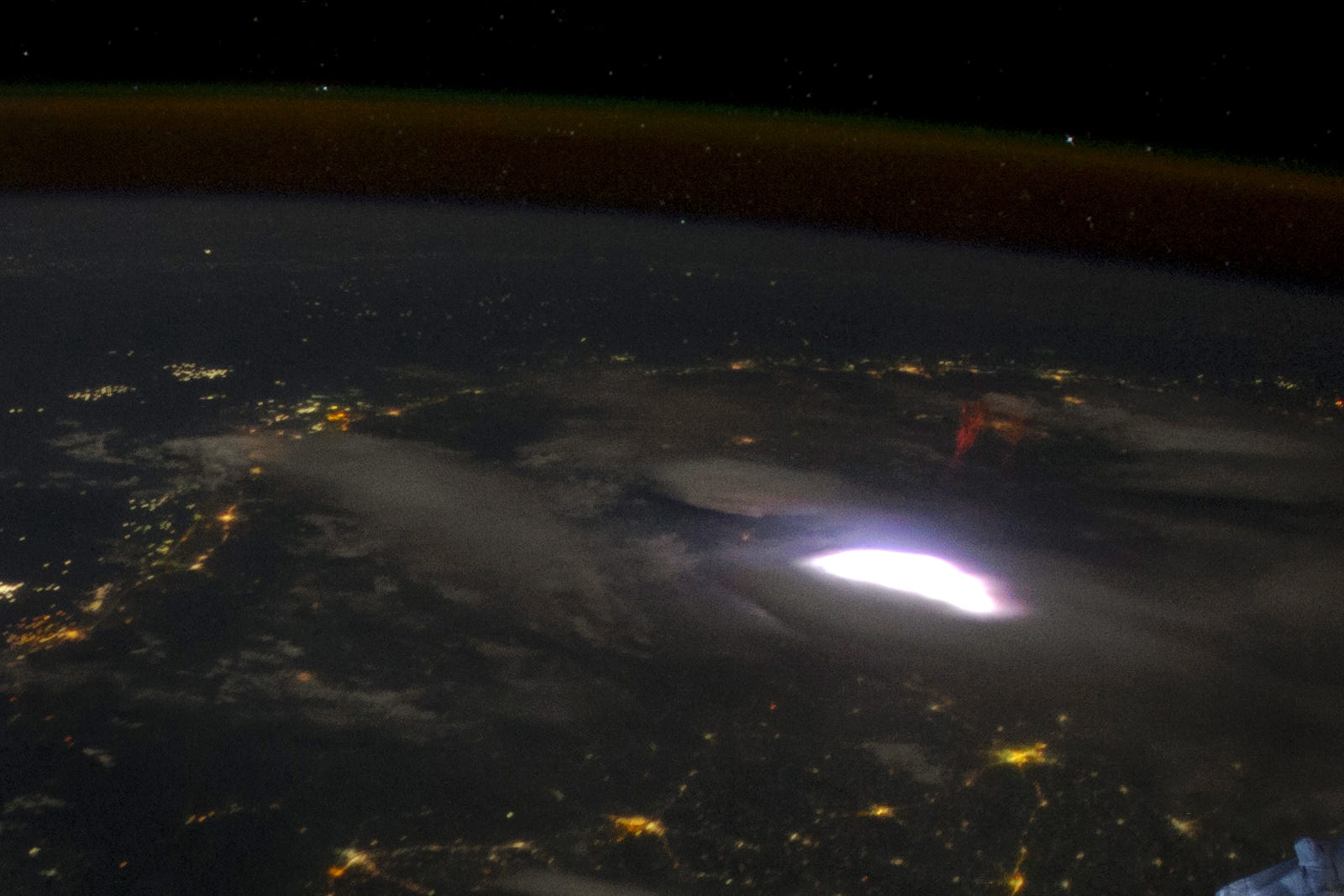
A bright red sprite appears above a lightning flash in a photo captured from the ISS
Back on April 30, Expedition 31 astronauts aboard the ISS captured this photo of a red sprite hovering above a bright flash of lightning over Myanmar. Elusive atmospheric phenomena, sprites are extremely brief bursts of electromagnetic activity that are associated with powerful lightning discharges, but exactly how and why they form isn’t yet known — although recent research (along with some incredible high-speed video) is shedding new light on sprites.
Although the appearance of bright high-altitude flashes above thunderstorms have been reported by pilots for nearly a century, it wasn’t until 1989 that a sprite was captured on camera — and the first color image of one wasn’t taken until 1994.
![]() So-named because of their elusive nature, sprites appear as several clusters of red tendrils above a lighting flash followed by a breakup into smaller streaks, often extending as high as 55 miles (90 km) into the atmosphere. The brightest region of a sprite is typically seen at altitudes of 40-45 miles (65-75 km).
So-named because of their elusive nature, sprites appear as several clusters of red tendrils above a lighting flash followed by a breakup into smaller streaks, often extending as high as 55 miles (90 km) into the atmosphere. The brightest region of a sprite is typically seen at altitudes of 40-45 miles (65-75 km).
Because they occur above storms, only last for a thousandth of a second and emit light in the red portion of the visible spectrum (to which our eyes are the least sensitive) studying sprites has been notoriously difficult for atmospheric scientists. Space Station residents may get great views but they have lots of other things to do in the course of their day besides sprite hunting! Luckily, a team of scientists were able to capture some unprecedented videos of sprites from airplanes in the summer of 2011, using high-speed cameras and help from Japan’s NHK television.
Chasing storms over Denver via plane for two weeks, researchers were able to locate “hot zones” of sprites and capture them on camera from two planes flying 12 miles apart. Combining their videos with ground-based measurements they were able to create 3-dimensional maps of the formation and evolution of individual sprites.
Based on the latest research, it’s suggested that sprites form as a result of a positive electrical charge within a lightning strike that reaches the ground, which leaves the top of the cloud negatively charged — a one-in-ten chance that then makes conditions above the cloud “just right” for a sprite to form higher in the atmosphere.
“Seeing these are spectacular,” said Hans C. Stenbaek-Nielsen, a geophysicist at the University of Alaska in Fairbanks, Alaska, where much sprite research has been conducted. “But we need the movies, because not only are they so fast that you could blink and miss them, but they emit most of their light in red, where the human eye is relatively blind.”
An example of how energy can be exchanged between lower and higher regions of Earth’s atmosphere, it’s been suggested that sprites could also be found on other planets as well, and may provide insight into the exotic chemistries of alien atmospheres.
Read more on NASA Heliophysics here.
Main image: Image Science & Analysis Laboratory, NASA Johnson Space Center. Inset image: the first color image of a sprite (NASA/UAF.) Video: NHK.
Shields Up! ISS Spacewalkers Install New Micrometeorite Shields
International Space Station Commander Gennady Padalka and Flight Engineer Yuri Malenchenko completed the first spacewalk of the Expedition 32 mission on Monday, Aug. 20, and successfully completed several tasks, including the installation of micrometeoroid debris shields on the exterior of the Zvezda service module and the deployment of a small science satellite.
Graphic showing the Debris Panel Installation Sites. Credit: NASA
The primary task during the five-hour, 51-minute EVA was to move the Strela-2 cargo boom from the Pirs docking compartment to the Zarya module. The move was another step in preparing Pirs for its eventual undocking and disposal, which will make room for the docking of the new Russian multipurpose laboratory module to the Zvezda nadir port.
This was the 163rd in support of station assembly and maintenance.
A second Expedition 32 spacewalk, scheduled for Aug. 30, will be conducted by NASA Flight Engineer Sunita Williams and Japan Aerospace Exploration Agency Flight Engineer Akihiko Hoshide. This will be the first U.S.-based spacewalk in over a year, since July 2011. During the planned 6.5-hour EVA, the astronauts will replace a faulty power relay unit on the station’s truss, rig power cables for the arrival late next year of a Russian laboratory module, replace a failing robotic arm camera and install a thermal cover on a docking port.
Progress Resupply Ship Takes Fast-Track to ISS, Arriving 6 Hours After Launch
After a flawless launch, an unmanned Russian Progress resupply ship used a new expedited technique to reach the International Space Station in hours instead of days. Progress 48 was loaded with almost three tons of food, fuel and supplies for the six crew members, and it docked successfully to the Pirs docking compartment on August 1, just six hours after the launch from the Baikonur Cosmodrome in Kazakhstan at 19:35 UTC (3:35 p.m. EDT, 1:35 a.m. Aug. 2 Baikonur time). The fast trip and rendezvous was designed to test a method for conducting additional firings of the Progress engines early in its mission to expedite the time required for a Russian vehicle to reach the complex.
Russian officials say the technique could be applied to manned Soyuz vehicles in the future to improve crew comfort and extend the life of the Soyuz return vehicle.
Russian cosmonaut Gennady Padalka has been quoted as saying it is every cosmonaut’s dream to only have a 6-hour flight in the cramped Soyuz!
Russian engineers and managers are still assessing the new technique, but by all appearances the quick trip seemed to be a great success. This Progress vehicle will stay at the ISS until December.
During the docking, NASA also tested a new technique of attitude control for the ISS which will save fuel, requiring 10 times less fuel to put the station in the proper orientation relative to Earth for the unpiloted cargo vehicle’s arrival.
According to Pooja Jesrani, lead attitude determination and control officer (ADCO) for this expedition at the Mission Control Center in Houston, the new maneuver is called the optimal propellant maneuver, or OPM. OPM is an improvement on the standard zero propellant maneuver, or ZPM, also developed by Draper Laboratory. The OPM takes into account the need to make the orientation, or attitude, changes to the space station faster than the ZPM. This speed avoids thermal concerns on the exterior of the station’s modules.
“Maneuvers such as the OPM will increase the International Space Station’s efficiency by using less propellant,” Jesrani said. “Additionally, the reduction in thruster firings during an OPM results in the station enduring lower structural loads. These benefits, among others, will help increase the longevity of the station.”
The maneuvers to and from the docking attitude are expected to save more than 90 percent of the fuel typically used when a Russian cargo spacecraft docks with the orbiting outpost.
Source: NASA
Japanese HTV-3 Berthed to International Space Station
The HTV-3 Japanese cargo spacecraft was successfully captured with the International Space Station’s Canadarm 2 robotic arm, and then installed to a docking port. JAXA astronaut Aki Hoshide berthed the HTV supply ship, called Kounotori3, or “white stork,” at 14:19 GMT (10:19 EDT) on July 27, 2012 to the Earth-facing side of the Harmony node on the ISS.
Above is a timelapse of the capture and berthing provided by SpaceVids.
Continue reading “Japanese HTV-3 Berthed to International Space Station”
An Orbital Adagio: Nighttime Views from the ISS
People keep making these videos from ISS photography, and we keep loving them. Here’s the latest, assembled by photographer Knate Myers to a track by John Murphy (from the movie soundtrack for Sunshine) it’s a beautiful tour of nighttime passes of the Space Station over our planet. Stars, city lights, airglow, aurorae… it’s nothing you haven’t seen before, but everything worth seeing again. Watch it.
Video: Knate Myers. All images courtesy of the Image Science & Analysis Laboratory, NASA Johnson Space Center. Via the Gateway to Astronaut Photography of Earth.
Japanese Cargo Ship Launches to Space Station
A Japanese resupply ship, the HTV-3 “Kountouri” (White Stork) launched Saturday to the International Space Station, lifting off on an H-IIB into overcast skies from the island of Tanegashima at 02:06 UTC. About 15 minutes after the launch, the cargo ship was released from the rocket and is now in orbit catching up to the space station. The Kountouri contains supplies such as food, clothing and equipment for experiments.
Continue reading “Japanese Cargo Ship Launches to Space Station”

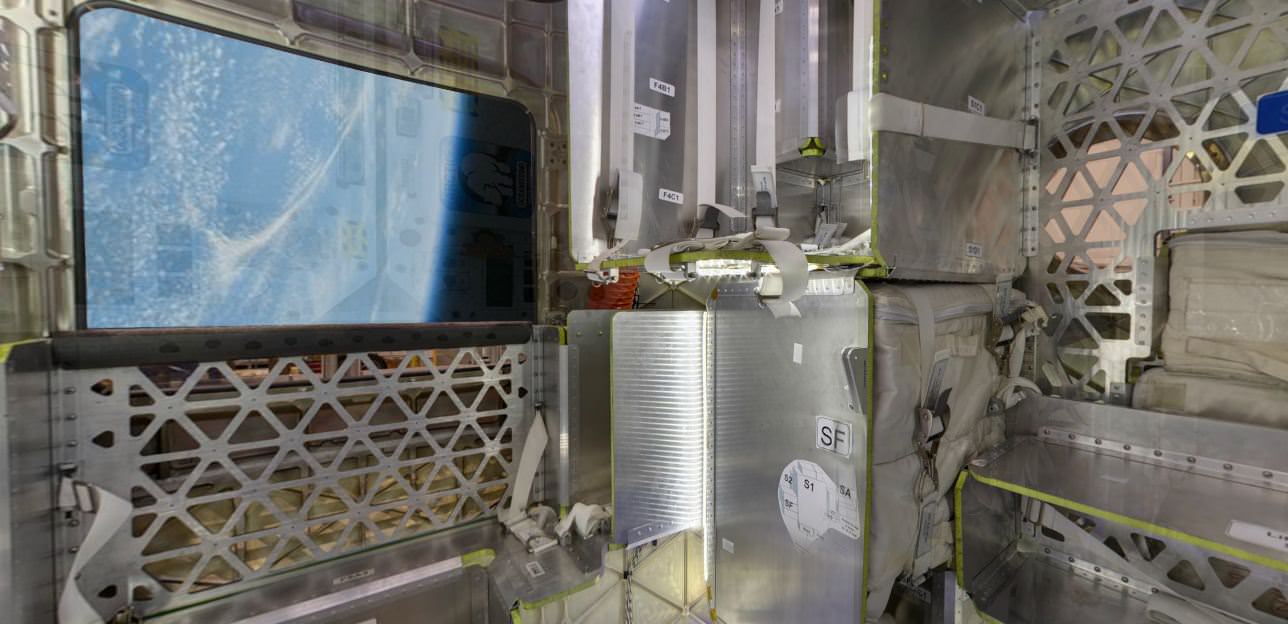
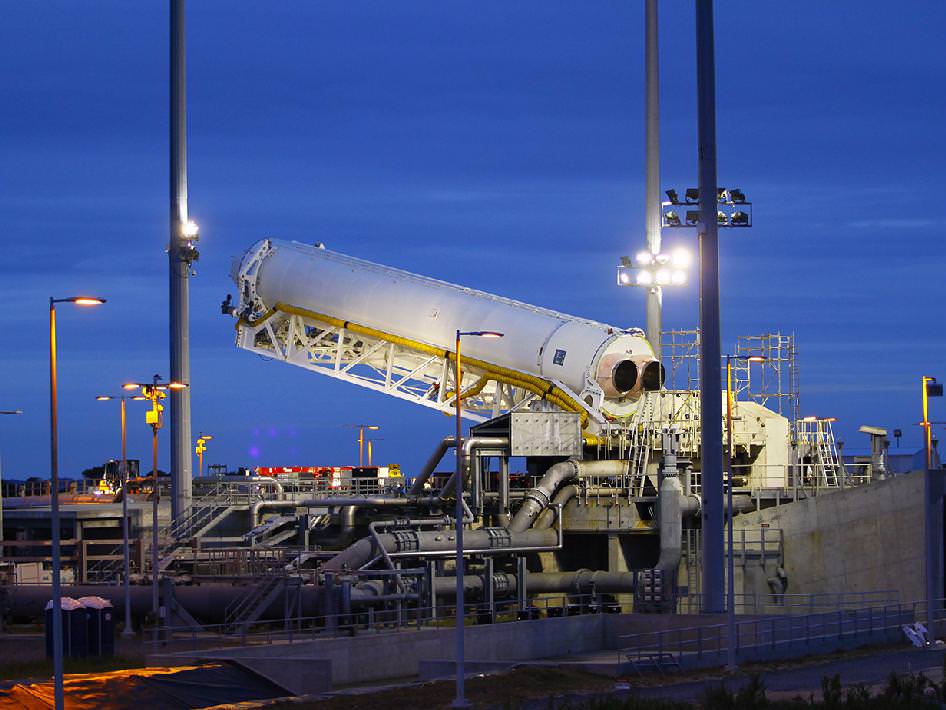
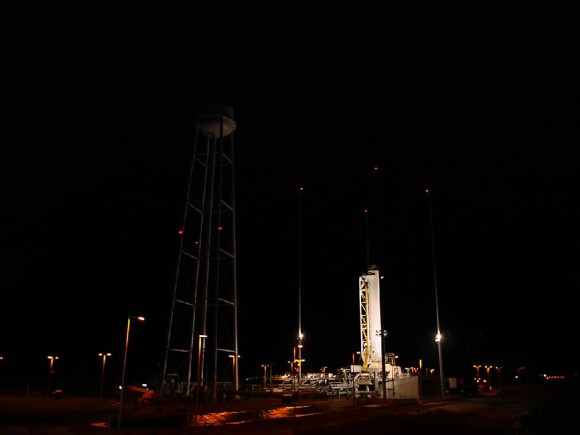
![A4IAv1HCQAEY5lM[1]](https://www.universetoday.com/wp-content/uploads/2012/10/A4IAv1HCQAEY5lM1-580x429.jpg)
